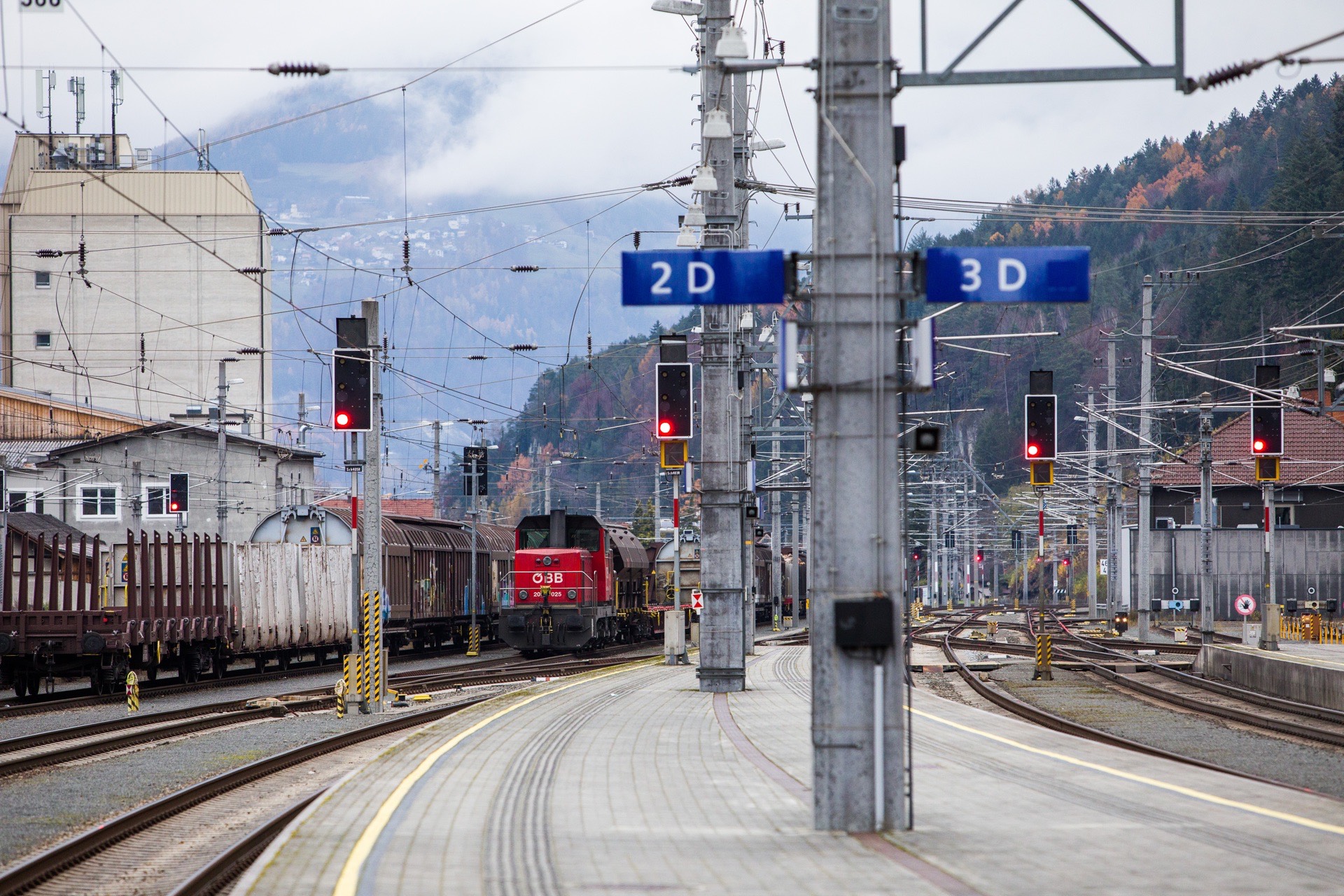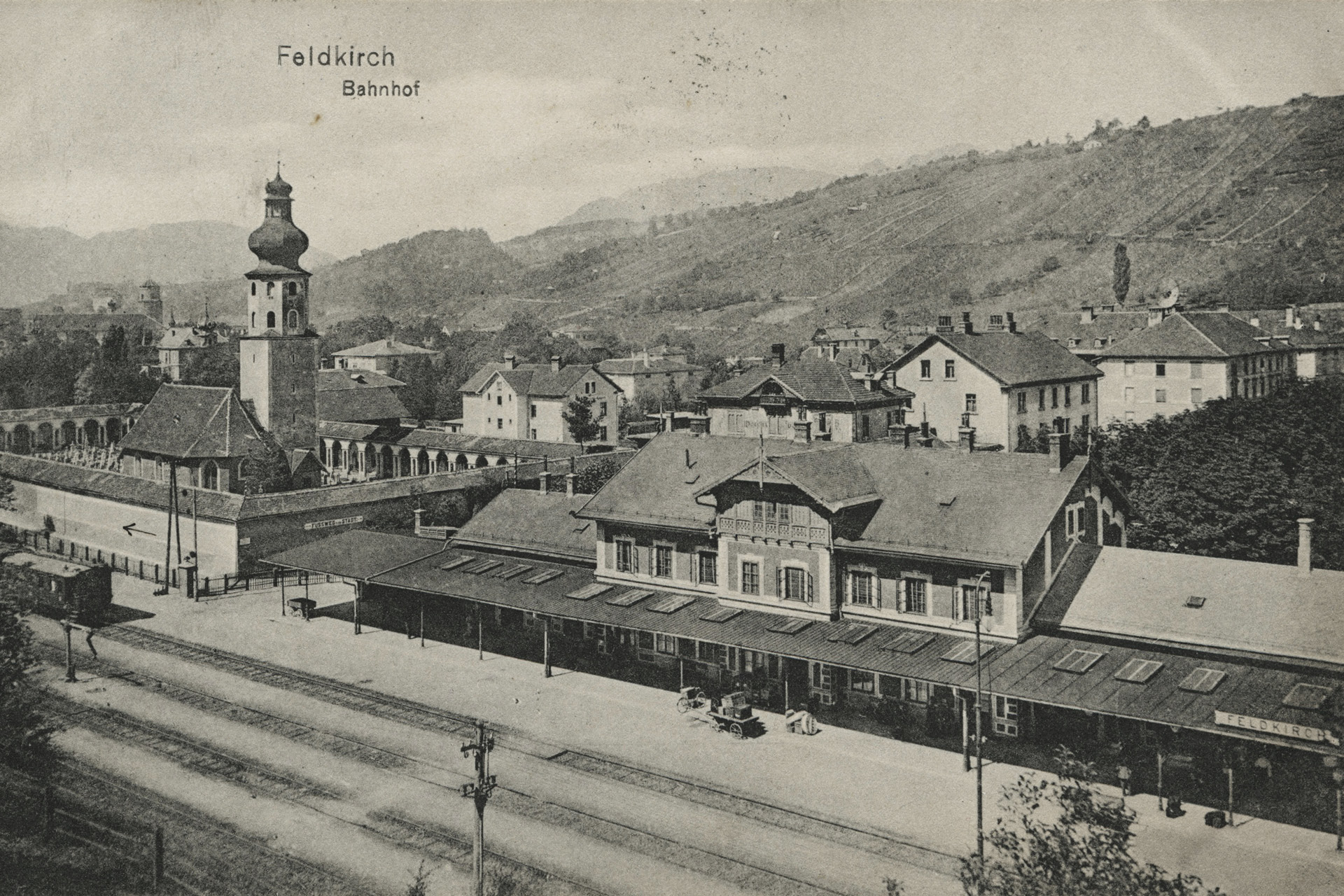40 Slowakische Juden> 7. Januar 1943
Text einblenden:
40 Fourteen Jews from Slovakia
A stuck sliding door betrays them: fourteen Jewish refugees from Slovakia are dragged off a coal train
Feldkirch, January 7, 1943
A goods train carrying brown coal is cleared by customs for the border crossing into Switzerland. Main customs assistant Reithmeyer notes in the chronicle of the Feldkirch main customs office:
“When trying to open the wagon SZ 17068, the officials become suspicious. The sliding door was stuck. It can only be opened by lifting it with a crowbar underneath.”1
The car is overloaded, which arouses suspicion. The officers start to unload the car. Then a man jumps out of a ventilation flap. He is arrested by the customs secretary.
“In the meantime, the other officers dig through the front wall of the wagon and discover a hole that almost reaches the bottom of the wagon. In it they find four refugees. By removing more coal they create an exit, then they force those found to leave the car. However, they resist, but are soon demanded to crawl out at gunpoint. The refugees are all black in the face from coal dust and dirty, but seem to be in good physical condition.”
Reithmeyer writes more in his report:
“In the meantime, the refugees, all of whom turn out to be Jews, have surrendered to their fate after initially being very depressed. They look rather adventurous enough. They have covered their faces with scarves to protect them from the frost and cold, so that only their eyes and – dirty – noses are showing. They wear many clothes on their bodies; 5-6 trousers and 3-4 jumpers. When asked if there are other men hidden in the wagons, they deny it and assure: only the five of us. Of course, the officers do not rely on this statement and search the other cars as well. They discover another five men in one of them and three men and a 17-year-old girl in one of the others. All Jews. ... The girl asks with her hands up in fear: ‘What is happening to us?’ When asked why he had fled, one of the Jews explained: ‘Because I wanted to save live’. When questioned more in detail, the Jews explain that they boarded the wagons in Slovakia on 30 December 1942 in order to avoid being deported to a labor camp.”
By this time, 58,000 Jews from Slovakia had already been deported to Auschwitz and Majdanek. Most of them were murdered. But not all the refugees on the coal train at the Feldkirch railway station were from Slovakia.
In Bukowsko, Poland, only a few miles north of the border, word also spread in autumn 1942 that there was an escape organization in Medzilaborce, a small Slovakian town in the Beskids. Small groups are hidden in the goods trains loaded with brown coal that are dispatched from there to Switzerland. Several of them actually reach Switzerland by December 31.
Among the people from Bukowsko and other Polish towns in the area who try to save themselves this way are the Balbirer siblings. In September 1942, the family is deported to the nearby labor camp Zaslaw near Sanok. From there, the parents David and Rosa are deported to an extermination camp. Meanwhile, Feige, the eldest daughter, hid with a group in the woods near Bukowsko.
The three other siblings also manage to return to their hometown from the camp for a few days, shortly before the Yom Kippur holiday: Basia, Gittel and Mendel – they are 15, 17 and 20 years of age. They do not fast or pray on Yom Kippur, Basia later recalls. “We said there is no God. Everything is a lie.”2
Feige visits them one more time during those days, looking for something to eat. Then she is caught by the SS and shot to death.
With the help of Hersch Greiber, an acquaintance from Bukowsko who had already gained experience in smuggling, the three siblings manage to escape from the Zaslaw camp once again. Just in time before the remaining ones are deported to the Belzec extermination camp. They reach Medzilaborce at the end of November or beginning of December. They are not the only Polish Jews here who now pose as Slovakian Jews to increase their chances of survival in case they are caught.
Not everyone can leave together. The places are rare and in great demand. Gittel leaves as early as December 30, her siblings are assigned a place in the bunker under the coal two weeks later. At this point, no one in Medzilaborce knows that Gittel's train was discovered in Feldkirch on January 7, 1943.
Gittel Balbirer, the seventeen-year-old “girl” in Reithmeyer's report, is detained for a few days in Feldkirch prison. In the entry log of the prisoner's register she appears under the false name she had adopted for her escape: Sara Schönfeld. On January 15, before her siblings are also arrested in Feldkirch, Gittel Balbirer is taken on to Vienna. From there she is finally deported to Auschwitz on March 3, together with about 30 other Slovakian and Polish Jews on transport number 47a. There her trace is lost.
Her siblings Mendel and Basia are first transferred to the prison in Bregenz. From there to the Reichenau concentration camp near Innsbruck. They also arrive in Auschwitz in May 1943.
Basia and Mendel survive and experience the liberation in 1945. After three years as displaced persons in Austria, they emigrate to Montevideo in Uruguay, in 1948. On the ship Partizanka. They never saw their sister Gittel again, neither in Auschwitz nor afterwards.[4]
[1] Chronicle of the Feldkirch Main Customs Office, 7.1.1943, Feldkirch City Archives
[2] Basia (Basha) Balbirer, interview in Petah Tikva, 8.6.2010, Yad Vashem Archive. Further information on the family's history also comes from this interview.
[3] Feldkirch Prison, record book 1942-1943, VLA
[4] Until the end of their lives (Mendel died in 2015 and Basia in 2021) they both tried to clarify the fate of their sister. But it was only an email from Mendel's daughter in Canada to the Jewish Community for Tyrol and Vorarlberg in 2022 that set in motion the research which made it possible to reconstruct Gittel‘s route from Feldkirch to Auschwitz. It is uncertain if and when she died there or whether she was deported further from Auschwitz.
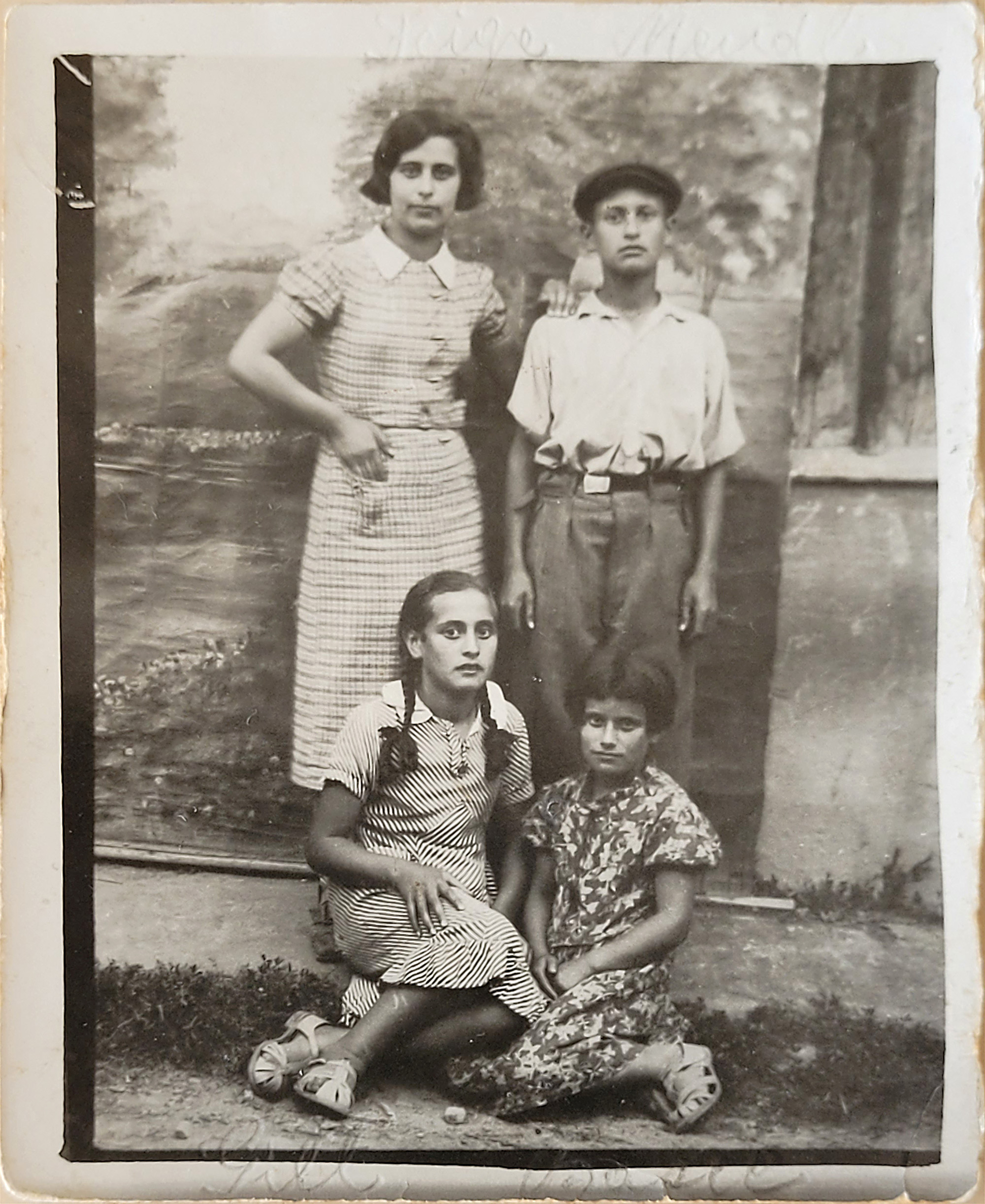
The Balbirer siblings: Feige, Mendel, Basia, Gittel (clockwise from top left), 1936
Family Archive
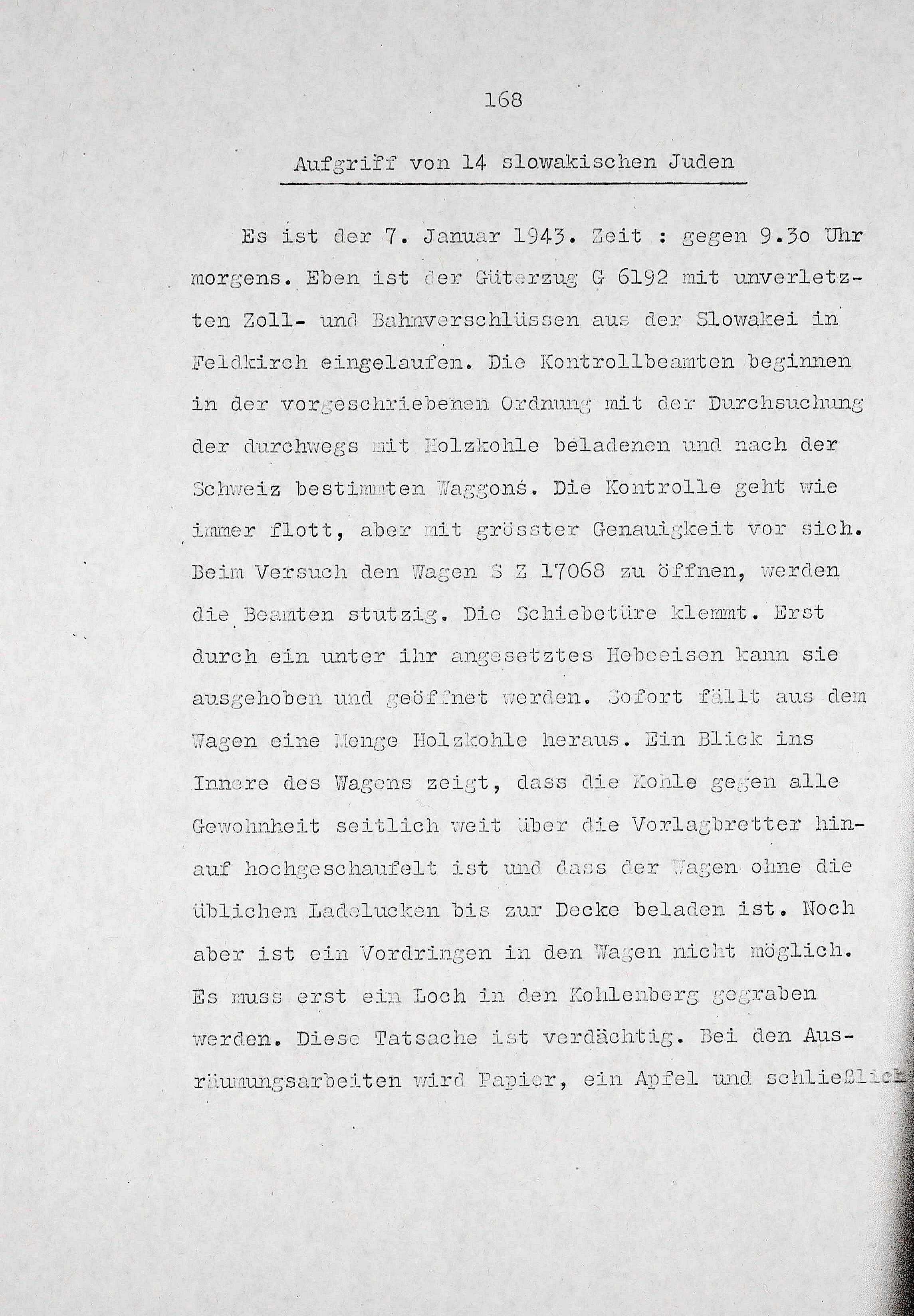
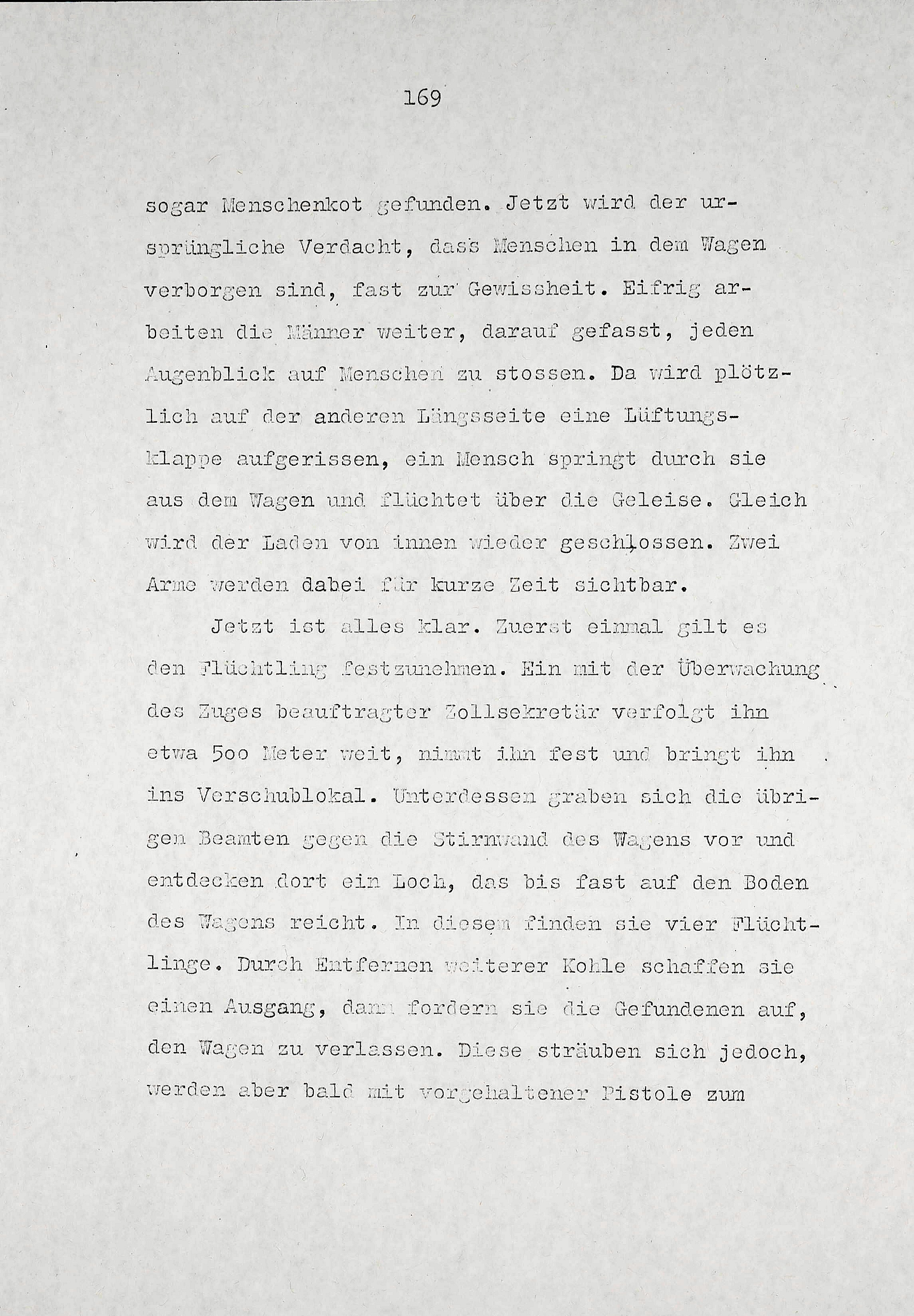
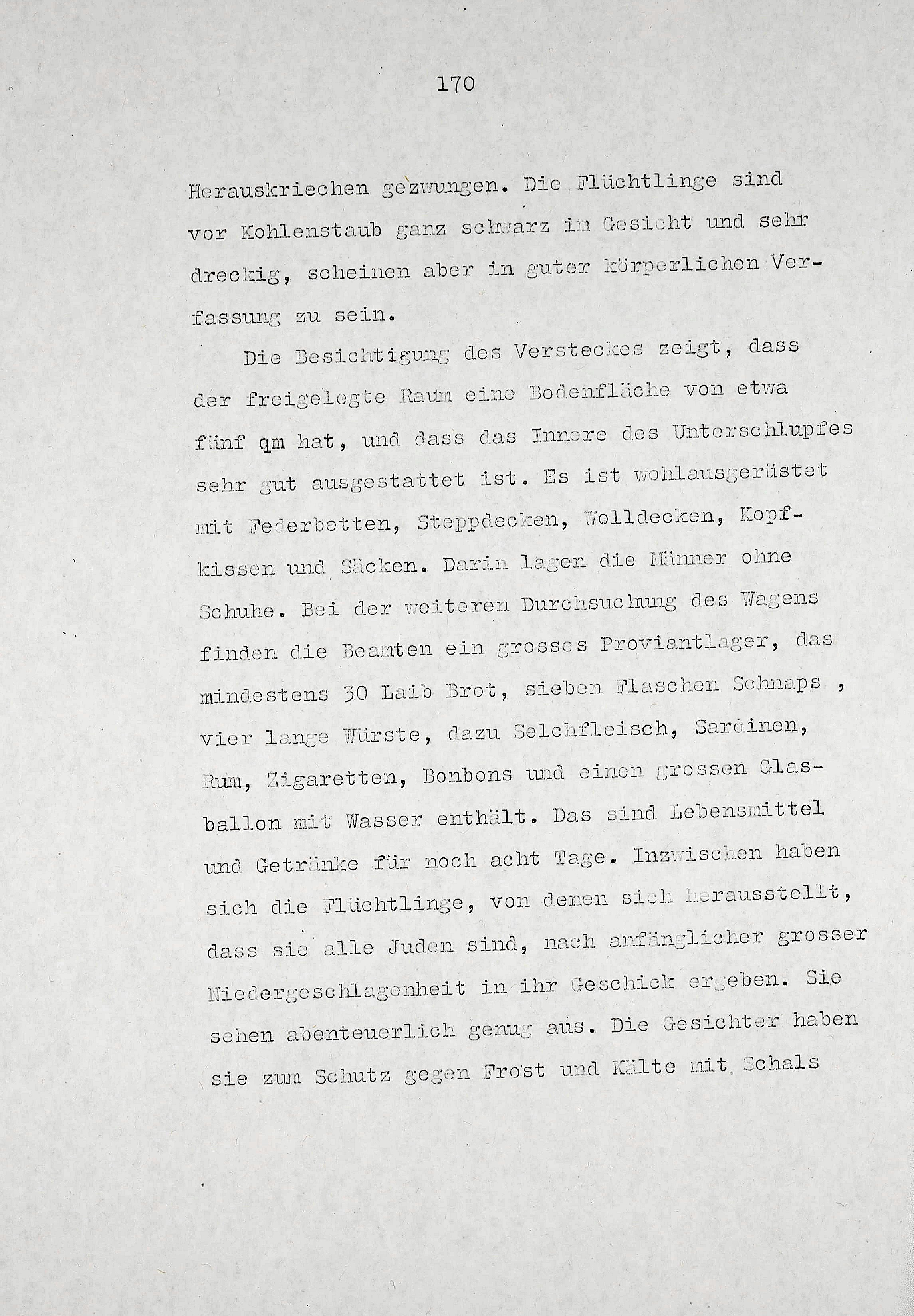
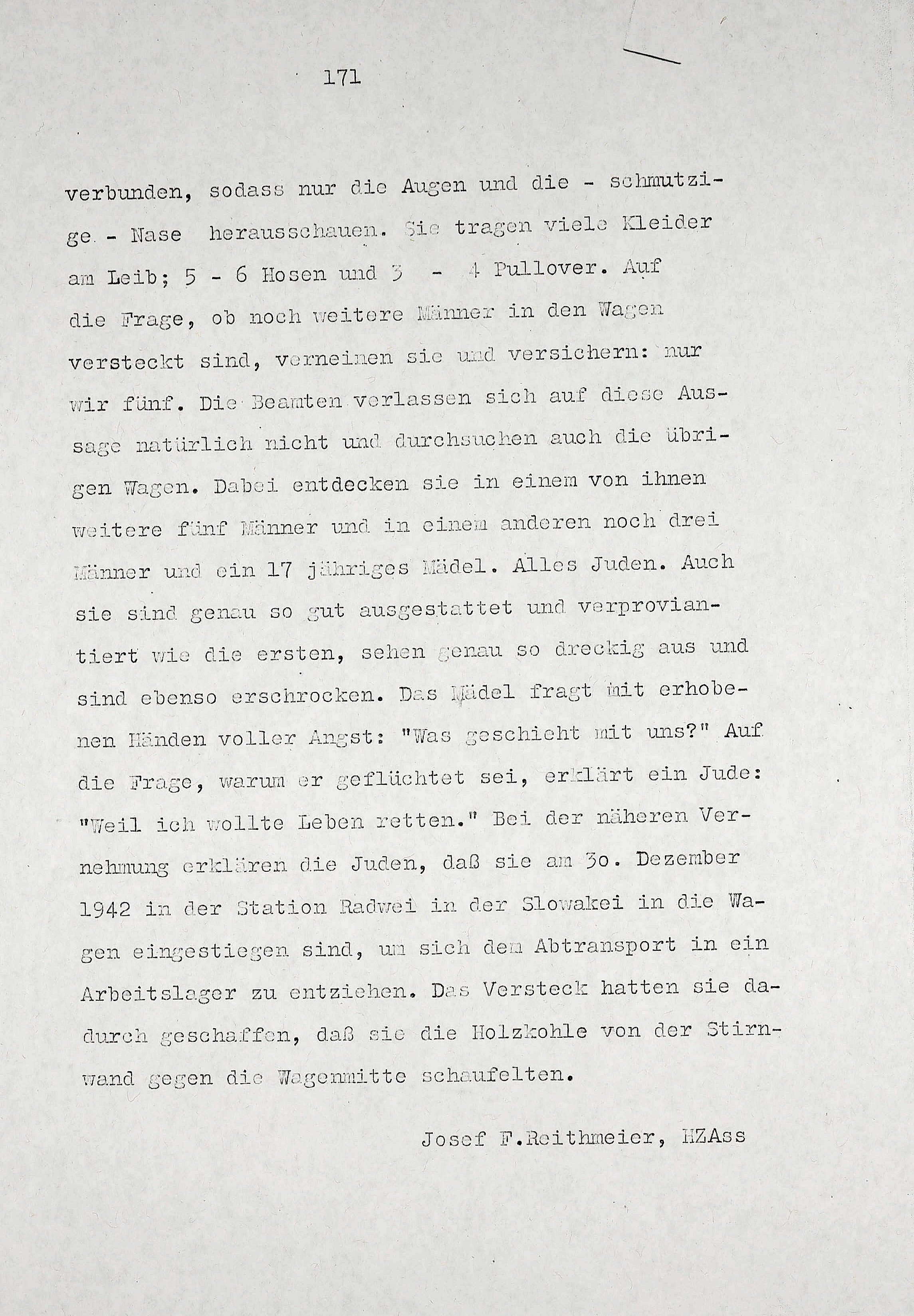
Chronicle of the Feldkirch Main Customs Office, 7.1.1943
Feldkirch City Archives
40 Fourteen Jews from Slovakia
A stuck sliding door betrays them: fourteen Jewish refugees from Slovakia are dragged off a coal train
Feldkirch, January 7, 1943
A goods train carrying brown coal is cleared by customs for the border crossing into Switzerland. Main customs assistant Reithmeyer notes in the chronicle of the Feldkirch main customs office:
“When trying to open the wagon SZ 17068, the officials become suspicious. The sliding door was stuck. It can only be opened by lifting it with a crowbar underneath.”1
The car is overloaded, which arouses suspicion. The officers start to unload the car. Then a man jumps out of a ventilation flap. He is arrested by the customs secretary.
“In the meantime, the other officers dig through the front wall of the wagon and discover a hole that almost reaches the bottom of the wagon. In it they find four refugees. By removing more coal they create an exit, then they force those found to leave the car. However, they resist, but are soon demanded to crawl out at gunpoint. The refugees are all black in the face from coal dust and dirty, but seem to be in good physical condition.”
Reithmeyer writes more in his report:
“In the meantime, the refugees, all of whom turn out to be Jews, have surrendered to their fate after initially being very depressed. They look rather adventurous enough. They have covered their faces with scarves to protect them from the frost and cold, so that only their eyes and – dirty – noses are showing. They wear many clothes on their bodies; 5-6 trousers and 3-4 jumpers. When asked if there are other men hidden in the wagons, they deny it and assure: only the five of us. Of course, the officers do not rely on this statement and search the other cars as well. They discover another five men in one of them and three men and a 17-year-old girl in one of the others. All Jews. ... The girl asks with her hands up in fear: ‘What is happening to us?’ When asked why he had fled, one of the Jews explained: ‘Because I wanted to save live’. When questioned more in detail, the Jews explain that they boarded the wagons in Slovakia on 30 December 1942 in order to avoid being deported to a labor camp.”
By this time, 58,000 Jews from Slovakia had already been deported to Auschwitz and Majdanek. Most of them were murdered. But not all the refugees on the coal train at the Feldkirch railway station were from Slovakia.
In Bukowsko, Poland, only a few miles north of the border, word also spread in autumn 1942 that there was an escape organization in Medzilaborce, a small Slovakian town in the Beskids. Small groups are hidden in the goods trains loaded with brown coal that are dispatched from there to Switzerland. Several of them actually reach Switzerland by December 31.
Among the people from Bukowsko and other Polish towns in the area who try to save themselves this way are the Balbirer siblings. In September 1942, the family is deported to the nearby labor camp Zaslaw near Sanok. From there, the parents David and Rosa are deported to an extermination camp. Meanwhile, Feige, the eldest daughter, hid with a group in the woods near Bukowsko.
The three other siblings also manage to return to their hometown from the camp for a few days, shortly before the Yom Kippur holiday: Basia, Gittel and Mendel – they are 15, 17 and 20 years of age. They do not fast or pray on Yom Kippur, Basia later recalls. “We said there is no God. Everything is a lie.”2
Feige visits them one more time during those days, looking for something to eat. Then she is caught by the SS and shot to death.
With the help of Hersch Greiber, an acquaintance from Bukowsko who had already gained experience in smuggling, the three siblings manage to escape from the Zaslaw camp once again. Just in time before the remaining ones are deported to the Belzec extermination camp. They reach Medzilaborce at the end of November or beginning of December. They are not the only Polish Jews here who now pose as Slovakian Jews to increase their chances of survival in case they are caught.
Not everyone can leave together. The places are rare and in great demand. Gittel leaves as early as December 30, her siblings are assigned a place in the bunker under the coal two weeks later. At this point, no one in Medzilaborce knows that Gittel's train was discovered in Feldkirch on January 7, 1943.
Gittel Balbirer, the seventeen-year-old “girl” in Reithmeyer's report, is detained for a few days in Feldkirch prison. In the entry log of the prisoner's register she appears under the false name she had adopted for her escape: Sara Schönfeld. On January 15, before her siblings are also arrested in Feldkirch, Gittel Balbirer is taken on to Vienna. From there she is finally deported to Auschwitz on March 3, together with about 30 other Slovakian and Polish Jews on transport number 47a. There her trace is lost.
Her siblings Mendel and Basia are first transferred to the prison in Bregenz. From there to the Reichenau concentration camp near Innsbruck. They also arrive in Auschwitz in May 1943.
Basia and Mendel survive and experience the liberation in 1945. After three years as displaced persons in Austria, they emigrate to Montevideo in Uruguay, in 1948. On the ship Partizanka. They never saw their sister Gittel again, neither in Auschwitz nor afterwards.[4]
[1] Chronicle of the Feldkirch Main Customs Office, 7.1.1943, Feldkirch City Archives
[2] Basia (Basha) Balbirer, interview in Petah Tikva, 8.6.2010, Yad Vashem Archive. Further information on the family's history also comes from this interview.
[3] Feldkirch Prison, record book 1942-1943, VLA
[4] Until the end of their lives (Mendel died in 2015 and Basia in 2021) they both tried to clarify the fate of their sister. But it was only an email from Mendel's daughter in Canada to the Jewish Community for Tyrol and Vorarlberg in 2022 that set in motion the research which made it possible to reconstruct Gittel‘s route from Feldkirch to Auschwitz. It is uncertain if and when she died there or whether she was deported further from Auschwitz.

The Balbirer siblings: Feige, Mendel, Basia, Gittel (clockwise from top left), 1936
Family Archive




Chronicle of the Feldkirch Main Customs Office, 7.1.1943
Feldkirch City Archives
